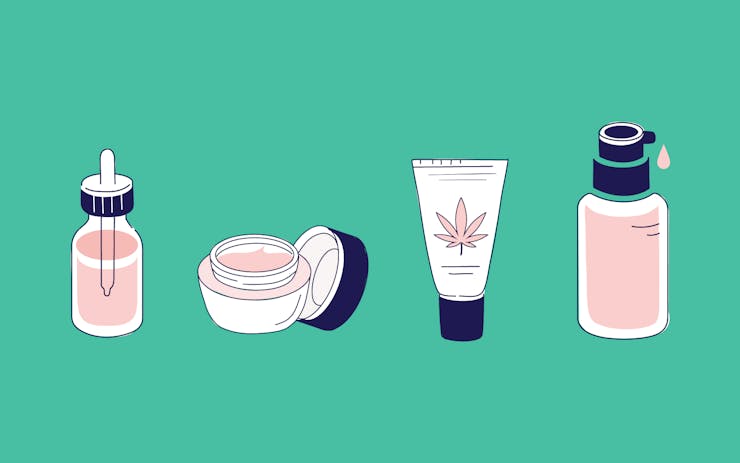CBD products are not only popular, but also far easier to get your hands on than widely prohibited THC products. There are many ways to use CBD, but topicals are one of the most accessible. However, before choosing one off the shelf or online, there are a few things to know first.
What are CBD topicals?
CBD, or cannabidiol, is a compound produced by cannabis and hemp plants. Unlike THC, CBD doesn’t produce a feeling of being high.
CBD topicals such as lotions, balms, gels, or creams are infused with CBD to produce skin-friendly products that contain the medicinal properties of CBD. In topical form, CBD is most popularly used for managing pain and inflammation.
Is a CBD topical right for me?
CBD topicals penetrate the skin to provide targeted relief, without entering the bloodstream. This makes them a fantastic choice for anyone who wants to focus the healing properties in specific problem areas rather than feel the effects throughout their body. CBD topicals can potentially provide relief for a variety of pain, headache, and skin issues such as:
- Joint or muscle pain
- Dermatitis
- Eczema
- Psoriasis
- Headaches/migraines
- Menstrual cramps
- Foot or hand pain
- Arthritis
Lo Friesen, lead chemist for cannabis wellness company Heylo, believes CBD topicals are also a fantastic preventative medicine. She says using these topicals every day, multiple times a day allows the body to not only uptake CBD quicker, but also build a CBD level in those areas and prevent worsening inflammation.
“It’s just preventative maintenance,” says Friesen. “For example, people who have arthritis in their hands who use [CBD topicals] on their hands every day are going to have less pain, less inflammation. They’re going to have less pain in their hands over time than people who use it to treat [the pain as it happens].”
What other ingredients are in CBD topicals?
Some CBD topicals may have bases such as shea butter, or oils like coconut, avocado, jojoba, or vitamin E. These nourishing ingredients are great for the skin, providing added benefit to the medicinal properties of CBD. It’s also possible to find more traditional lotions with CBD or products with an Aquaphor base.
While lotions will be water based, creams usually have a fat or oil base, and balms a thicker base such as beeswax. Water-based lotions absorb more quickly into the skin, but oil-based CBD topicals are more easily absorbed and get into the skin deeper. Meanwhile, gels can be useful for easier thicker application, making them possibly preferable for those with reduced hand dexterity, such as arthritis patients.
At the end of the day however, Friesen says, “Just take your favorite skin care product and find something with similar ingredients, add CBD, and you’ve already made it better.”
How to tell quality CBD products from ‘snake oil’
Unfortunately, due to an oversaturated market and lack of regulation, not all CBD topicals will produce the desired results. CBD can be sourced from either hemp or traditional cannabis, but their resulting extracts typically have quite a few differences in terms of the diversity of compounds found within them.
Shop highly rated dispensaries near you
Showing you dispensaries nearCBD extracts from cannabis tend to include a wide diversity of helpful compounds whereas hemp’s chemical diversity is more limited. You’ll also want to make sure that a hemp-derived product actually contains CBD—hemp seeds or stalk don’t produce CBD, so it’s important to understand which part of the hemp plant was used in the extraction process.
What’s more, some products claim to have an abundance of CBD in them, but the reality doesn’t always match the label. So how can consumers make sure they are getting a quality product?
Dr. Jeremy Riggle, chief scientist with cannabis wellness company Mary’s Medicinals weighed in:
“Not all CBD products are created equal, and consumers should do their research. Ask questions—what type of CBD extract does it contain: full spectrum, broad spectrum, or isolate? Where is the raw material sourced from? Does the producer use organic and sustainable agricultural practices? Does the supplier have a Certificate of Analysis showing test results for pesticides, heavy metals, residual solvents, microbials, cannabinoid potency, and terpene profile?”
Finally, it’s worth noting that milligram content can make a difference, and with CBD, higher is generally better. Friesen says you get what you pay for, but that this is also why some make the switch over to CBD:THC topical products. Friesen believes these 1:1 or 1:3 ratio products are more effective than CBD on its own, due to the cannabinoids tendency to amplify each other’s effects. As such, patients may be able to use less to achieve similar effects, than they would with a CBD only product, and save money in the process.
All in all, there are plenty of great topical CBD products on the market for those who want to try a targeted method of delivering these helpful cannabinoids to problem areas and add CBD to their wellness routine.





